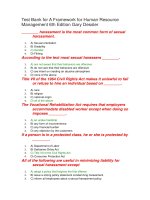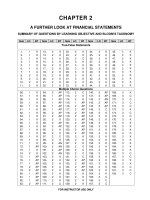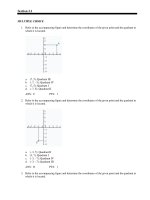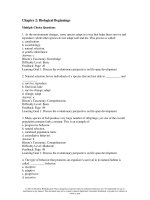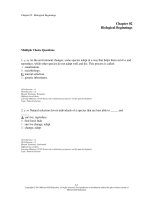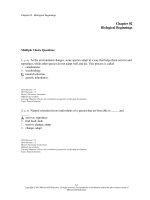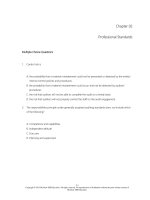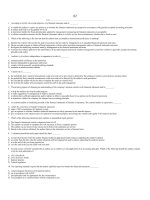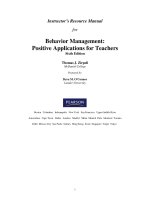Human resource development 6th edition werner test bank
Bạn đang xem bản rút gọn của tài liệu. Xem và tải ngay bản đầy đủ của tài liệu tại đây (232.01 KB, 8 trang )
Test Bank
119
CHAPTER 2—INFLUENCES ON EMPLOYEE BEHAVIOR
TRUE/FALSE
1.
Downsizing is the voluntary reduction in the size of the workforce
ANS: T
PTS:
Communication | HRM
2.
DIF:
Medium
Bloom’s: Knowledge
LO-5
REF:
Page 50
1
DIF:
Easy
Bloom’s: Knowledge
REF:
LO-5
Page 53
1
DIF:
Medium
Bloom’s: Knowledge
LO-3
REF:
Page 42
1
DIF:
Medium
Bloom’s: Knowledge
LO-4
REF:
Page 45
1
DIF:
Medium
Bloom’s: Knowledge
LO-3
REF:
Page 42
1
DIF:
Medium
Bloom’s: Knowledge
REF:
LO-3
Page 42
1
DIF:
Medium
Bloom’s: Knowledge
REF:
LO-6
Page 59
According to Wagner & Hollenbeck 5 employee outcomes are of particular interest.
ANS: F
PTS:
Communication | HRM
11.
1
The behavioral intentions model is based on a combination of attitudes and perceived social pressures to behave in a given way.
ANS: T
PTS:
Communication | HRM
10.
Page 47
Leadership is the coercive influence used to direct and coordinate the activities of a group toward accomplishing a goal.
ANS: F
PTS:
Communication | HRM
9.
REF:
According to the self-fulfilling prophecy a supervisors expectations of behavior can impact the employee's behavior
ANS: T
PTS:
Communication | HRM
8.
DIF:
Easy
Bloom’s: Knowledge
LO-5
Groupthink means that a group is 'smarter' than the individuals in the group.
ANS: F
PTS:
Communication | HRM
7.
1
The self-fulfilling prophecy is also called the Pygmalion effect
ANS: T
PTS:
Communication | HRM
6.
Page 39
According to social learning theory, self-efficacy is defined as a person's beliefs about their ability to perform a job.
ANS: T
PTS:
Communication | HRM
5.
REF:
In expectancy theory, the importance that an individual places upon a particular outcome is called instrumentality.
ANS:
F
PTS:
Communication | HRM
4.
DIF:
Easy
Bloom’s: Knowledge
LO-1
The motivational theories by Maslow and Alderfer are examples of cognitive theories of motivation.
ANS: F
PTS:
Communication | HRM
3.
1
1
DIF:
Medium
Bloom’s: Knowledge
REF:
LO-5
Page 57
Cohesiveness means that group members are willing to remain a part of the group?
ANS:
T
PTS:
Communication | HRM
1
DIF:
Easy
Bloom’s: Knowledge
REF:
LO-4
Page 46
Chapter 2—Influences on Employee Behavior
120
12.
In general need theories of motivation focus on a deficiency that energizes one’s behavior.
ANS: T
PTS:
Communication | HRM
13.
Page 52
1
DIF:
Easy
Bloom’s: Knowledge
REF:
LO-6
Page 59
1
DIF:
Medium
Bloom’s: Knowledge
REF:
LO-6
Page 61
1
REF:
LO-5
Page 52
REF:
LO-1
Page 37
DIF:
Easy
Bloom’s: Knowledge
1
DIF:
Easy
Bloom’s: Knowledge
1
DIF:
Easy
Bloom’s: Knowledge
REF:
LO-1
Page 39
REF:
Page 54
In equity theory employees compare themselves to their goals.
ANS: F
PTS:
Communication | HRM
20.
REF:
LO-5
Outcomes can be either personal to the employee or organizationally focused.
ANS: T
PTS:
Communication | HRM
19.
DIF:
Easy
Bloom’s: Knowledge
A major focus of most HRD interventions is to change employee behavior.
ANS: T
PTS:
Communication | HRM
18.
1
Goals do not need to be agreed to by employees to be effective.
ANS: F
PTS:
Communication | HRM
17.
Page 47
KSA stands for knowledge, skills and attitudes.
ANS: F
PTS:
Communication | HRM
16.
REF:
LO-5
Attitudes can easily be used to explain all behaviors.
ANS: F
PTS:
Communication | HRM
15.
DIF:
Easy
Bloom’s: Knowledge
Specific and difficult goals lead to higher performance than do vague and easy goals.
ANS: F
PTS:
Communication | HRM
14.
1
1
DIF:
Easy
Bloom’s: Knowledge
LO-5
The employee work outcomes in the Wagner-Hollenbeck model of motivation and performance are: Desire to perform, effort,
performance and motivation.
ANS: F
PTS:
Communication | HRM
1
DIF:
Medium
Bloom’s: Knowledge
REF:
LO-5
Page 57
Test Bank
121
MULTIPLE CHOICE
1.
External forces impacting employee behavior include all of the following except?
a. KSA's
b. Technology developments
c. Government laws
d. Economic conditions
ANS: A
PTS:
Communication | HRM
2.
DIF:
Medium
Bloom’s: Knowledge
REF:
LO-1
Page 40
1
DIF:
Easy
Bloom’s: Knowledge
REF:
LO-1
Page 39
1
DIF:
Medium
Bloom’s: Knowledge
REF:
LO-2
Page 40
1
DIF:
Easy
Bloom’s: Knowledge
REF:
LO-2
Page 41
In expectancy theory, the importance that an individual places upon a particular outcome is called a(n):
a. instrumentality
b. valence
c. expectancy
d. extrinsic motivation
ANS: B
PTS:
Communication | HRM
7.
1
An organizational outcome of employee behavior would include:
a. Downsizing
b. Pay
c. Productivity
d. Recognition
ANS: C
PTS:
Communication | HRM
6.
Page 39
A personal outcome of employee behavior would include:
a. Downsizing
b. Pay and recognition
c. Teamwork
d. Productivity
ANS: B
PTS:
Communication | HRM
5.
REF:
LO-1
Downsizing.
a. Is not very common among large companies
b. Was a trend of the 1950's but not seen often today
c. Usually causes a large jump in profits and stock price
d. Is a voluntary reduction in the overall size of the workforce
ANS: D
PTS:
Communication | HRM
4.
DIF:
Medium
Bloom’s: Knowledge
Internal forces impacting employee behavior include all of the following except?
a. Supervisors
b. Co-workers
c. Global influences
d. The organizational reward structure
ANS: C
PTS:
Communication | HRM
3.
1
1
DIF:
Easy
Bloom’s: Knowledge
REF:
LO-5
Page 51
According to social learning theory, self-efficacy is defined as a person's beliefs:
a. about their ability to successfully perform a particular task or activity
b. about their overall worth or sense of value
c. that performing a particular task will lead to a given outcome
d. that the cause of their behavior is something external to themselves
ANS: A
PTS:
Communication | HRM
1
DIF:
Medium
Bloom’s: Knowledge
REF:
LO-5
Page 53
Chapter 2—Influences on Employee Behavior
122
8.
Which motivation theory suggests that people compare the outcomes they received to the outcomes received by others?
a. equity theory
b. attribution theory
c. goal-setting theory
d. expectancy theory
ANS: A
PTS:
Communication | HRM
9.
DIF:
Easy
Bloom’s: Knowledge
REF:
LO-5
Page 56
1
DIF:
Medium
Bloom’s: Knowledge
REF:
LO-6
Page 59
1
DIF:
Easy
Bloom’s: Knowledge
REF:
LO-5
Page 47
1
DIF:
Medium
Bloom’s: Knowledge
REF:
LO-3
Page 42
The following are factors in the work environment that affect an employee's behavior EXCEPT:
a. supervision
b. coworkers
c. organizational design
d. outcomes
ANS: C
PTS:
Communication | HRM
14.
1
The idea that a supervisor's (or trainer's) expectations for an employee (or trainee) can influence the employee's (or trainee's)
behavior is referred to as the:
a. Pygmalion effect
b. vertical-dyad-linkage theory
c. path-goal theory
d. Groupthink theory
ANS: A
PTS:
Communication | HRM
13.
Page 54
The motivational theories by Maslow and Alderfer are examples of what type of motivational approach?
a. cognitive
b. meta-analytic
c. noncognitive
d. need-based
ANS: D
PTS:
Communication | HRM
12.
REF:
LO-5
A person's general feeling of favorableness or unfavorable toward some object is the definition of a(n):
a. ability
b. outcome
c. motivation
d. attitude
ANS: D
PTS:
Communication | HRM
11.
DIF:
Easy
Bloom’s: Knowledge
Reinforcement theory deals mainly with:
a. trainability
b. rewards and punishment
c. intrinsic motivation
d. the need for social belonging
ANS: B
PTS:
Communication | HRM
10.
1
1
DIF:
Easy
Bloom’s: Knowledge
REF:
LO-1
Page 40
DIF:
Medium
Bloom’s: Knowledge
REF:
LO-2
Page 38
Organizational Citizenship Behaviors (OCB) is:
a. Also called task performance
b. Never a job-related behavior
c. Required behavior by most organizations
d. Contribute to organizational effectiveness
ANS: D
PTS:
Communication | HRM
1
Test Bank
15.
According to the text an organization can influence employee behavior in the following ways EXCEPT:
a. bonus pay
b. culture
c. laws and regulations
d. job design
ANS: C
PTS:
Communication | HRM
16.
1
DIF:
Medium
Bloom’s: Knowledge
REF:
LO-5
Page 56
1
DIF:
Medium
Bloom’s: Knowledge
REF:
LO-6
Page 61
1
DIF:
Medium
Bloom’s: Knowledge
REF:
LO-1
Page 40
1
DIF:
Easy
Bloom’s: Knowledge
REF:
LO-1
Page 39
REF:
LO-1
Page 40
REF:
LO-3
Page 42
Employee behavior at work is not influenced by:
a. Coworkers
b. Political issues outside work
c. The organization reward structure
d. The supervisor one works for
ANS: B
PTS:
Communication | HRM
21.
Page 40
Downsizing is:
a. When one company buys another
b. When two companies merge their operations
c. When an employees work load is reduced by hiring more employees
d. When a company reduced the size of the work force
ANS: D
PTS:
Communication | HRM
20.
REF:
LO-4
Internal forces that impact employee behavior:
a. Organizational culture
b. Performance expectations
c. Job design
d. All of the above impact employee behavior
ANS: D
PTS:
Communication | HRM
19.
DIF:
Medium
Bloom’s: Knowledge
In terms of salesperson's knowledge, skills and abilities, which of the following task would be considered ability?
a. technical troubleshooting
b. "cold calling"
c. developing relationships
d. audiovisual expertise
ANS: C
PTS:
Communication | HRM
18.
1
Behavior modification principles suggest four choices for controlling an employee's behavior. These include all of the following
EXCEPT:
a. positive reinforcement
b. termination
c. extinction
d. negative reinforcement
ANS: B
PTS:
Communication | HRM
17.
123
1
DIF:
Easy
Bloom’s: Knowledge
The concept of the self-fulfilling prophecy is also called:
a. Pygmalion effect
b. Self efficacy
c. Instrumentality
d. Valence
ANS: A
PTS:
Communication | HRM
1
DIF:
Easy
Bloom’s: Knowledge
Chapter 2—Influences on Employee Behavior
124
22.
The self-fulfilling prophecy means that:
a. What you see is what you get
b. A picture is worth 1000 words
c. If you value the reward you will work hard
d. The supervisors expectations can impact employee behavior
ANS: D
PTS:
Communication | HRM
23.
DIF:
Medium
Bloom’s: Knowledge
REF:
LO-4
Page 44
1
DIF:
Medium
Bloom’s: Knowledge
REF:
LO-5
Page 42
1
DIF:
Medium
Bloom’s: Knowledge
REF:
LO-4
Page 44
1
DIF:
Medium
Bloom’s: Knowledge
REF:
LO-4
Page 45
REF:
LO-4
Page 45
REF:
LO-4
Page 44
Groupthink means that:
a. People are grouped at work by their IQ
b. People in groups usually seek unanimity
c. Groups spend more time thinking than doing
d. It actually does not exist as a concept
ANS: B
PTS:
Communication | HRM
28.
1
Job design is:
a. Not important in the way employees behave
b. A function of the tasks one performs and the scope of responsibilities
c. Done by HR Designers only once each year
d. The way the employee performs the job
ANS: B
PTS:
Communication | HRM
27.
Page 42
Organization culture is:
a. Illegal to talk about
b. Of no interest to training and development
c. A set of values, beliefs and patterns of behaviors that are shared by members of the organization
d. A factor only for management level employees
ANS: C
PTS:
Communication | HRM
26.
REF:
LO-3
According to path-goal theory of leadership motivation and job satisfaction will be high if:
a. The leader identifies the goals and clarifies the paths employees can take to reach these goals.
b. The leader identifies the goals and lets the employees seek their own path to reach these goals.
c. The leader lets the employee identify their own goals and then ignores their efforts
d. None of the above are true
ANS: A
PTS:
Communication | HRM
25.
DIF:
Medium
Bloom’s: Knowledge
The organization impacts employee behaviors based on:
a. The type, distribution and criteria for rewarding people
b. How much money a person makes compared to others
c. Whether or not there is a bonus
d. Pay has not impact on employee behaviors
ANS: A
PTS:
Communication | HRM
24.
1
1
DIF:
Medium
Bloom’s: Knowledge
Organizational rewards:
a. Includes only things like pay and benefits
b. Has no impact on employee behavior
c. Includes pay and intangible things like recognition.
d. Work most effectively when they are used as control mechanisms
ANS: C
PTS:
Communication | HRM
1
DIF:
Easy
Bloom’s: Knowledge
Test Bank
29.
A norm is best defined as:
a. A part of company policy
b. An informal rule for appropriate behavior with a group
c. A written policy for behavior
d. Something each employees makes up for themselves
ANS: B
PTS:
Communication | HRM
30.
1
DIF:
Easy
Bloom’s: Knowledge
REF:
LO-4
Page 45
1
DIF:
Easy
Bloom’s: Knowledge
REF:
LO-5
Page 49
1
DIF:
Easy
Bloom’s: Knowledge
REF:
LO-5
Page 49
1
DIF:
Medium
Bloom’s: Knowledge
REF:
LO-5
Page 49
Motivation focuses on all of the following processes affecting behavior except:
a. Energizing
b. Direction
c. Cohesiveness
d. Persistence
ANS: C
PTS:
Communication | HRM
35.
Page 45
Alderfer's theory of motivation:
a. Contains 2 factors - hygiene and motivator factors
b. Contains 5 categories of needs
c. Focuses on existence, relatedness and growth
d. None of the above are true
ANS: C
PTS:
Communication | HRM
34.
REF:
LO-4
Herzberg's theory of motivation:
a. Contains 2 factors - hygiene and motivator factors
b. Contains 5 categories of needs
c. Focuses on existence, relatedness and growth
d. None of the above are true
ANS: A
PTS:
Communication | HRM
33.
DIF:
Easy
Bloom’s: Knowledge
Maslow's need theory of motivation:
a. Contains 2 factors
b. Contains 5 categories of needs
c. Focuses on existence, relatedness and growth
d. None of the above are true
ANS: B
PTS:
Communication | HRM
32.
1
Social loafing:
a. Increases as group size increases
b. Goes down as the group gets smaller
c. Is a tendency of members to reduce performance
d. All of the above are true
ANS: D
PTS:
Communication | HRM
31.
125
1
DIF:
Easy
Bloom’s: Knowledge
REF:
LO-5
Page 46
REF:
LO-5
Page 52
Goals setting theory:
a. Is well supported by research
b. Works only for some employees
c. Has no role in training
d. Works only if the goals are easy to achieve
ANS: A
PTS:
Communication | HRM
1
DIF:
Easy
Bloom’s: Knowledge
Chapter 2—Influences on Employee Behavior
126
36.
According to Social Learning Theory a person's self-efficacy expectations will determine:
a. Whether or not they will do the task correctly
b. How much effort a person will spend on a task
c. The size of the reward they expect
d. Whether or not they like doing the task
ANS: B
PTS:
Communication | HRM
37.
Page 53
1
DIF:
Medium
Bloom’s: Knowledge
REF:
LO-5
Page 54
1
DIF:
Medium
Bloom’s: Knowledge
REF:
LO-5
Page 59
Abilities
a. Are a combination of what you can do and what you have learned over time
b. Reflects what you have been trained to do
c. Are an understanding you have of a particular subject
d. Are a general capacity to perform a task
ANS: D
PTS:
Communication | HRM
40.
REF:
LO-5
The behavioral intentions model:
a. Explains why attitudes always predict actual behaviors
b. Impact behavior only to the extent that they influence one's intentions
c. Is the best way to evaluate a training program
d. Has no link to employee's intentions to use what they learn during a training program.
ANS: B
PTS:
Communication | HRM
39.
DIF:
Medium
Bloom’s: Knowledge
Which is the correct sequence of events according to Behavior modeling theory?
a. Let them see a model, tell the trainee what to do practice, feedback and social reinforcement
b. Tell the trainee what to do, let them see a model, practice, feedback and social reinforcement
c. Tell the trainee what to do, let them see a model, feedback, practice and social reinforcement
d. Tell the trainee what to do, let them see a model, social reinforcement, practice and feedback
ANS: D
PTS:
Communication | HRM
38.
1
1
DIF:
Medium
Bloom’s: Knowledge
A major goal of HRD efforts includes all except:
a. Stay within budget
b. Help employees attain their goals
ANS: A
PTS:
Communication | HRM
1
c.
d.
REF:
LO-6
Page 61
Improve organizational performance
Change employee behavior
DIF:
Medium
Bloom’s: Knowledge
REF:
LO-2
Page 37
